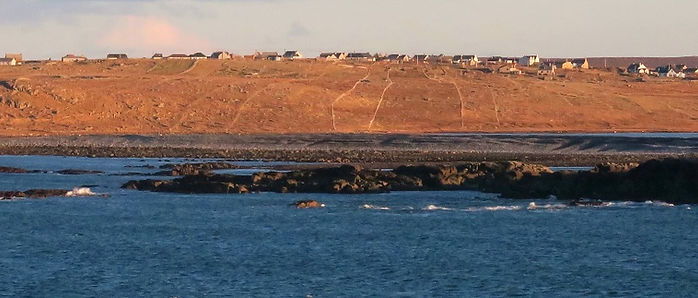SEASONS I VILLAGES I COASTLAND I MOORLAND I HISTORICAL SITES I WALKING
BIRDWATCHING I WILDFLOWERS I WATERSPORTS I CYCLING I EXPLORE THE ISLAND
Villages
Rugadh an Àrnol Fiullagan
Bragar and Arnol are both ancient villages, going back into the mists of time, with many of the local families living in this area for countless generations. But our villages, and the substantial rural population in all parts of Lewis, might have been swept away and the people cleared off the land, as happened in many parts of the highlands. That we remain here today is because the Lewis people of the 19th and early 20th centuries were prepared to fight the power of landlordism and insist on staying on the land their ancestors had occupied. See The Lewis Land Struggle, Na Gaisgich by Joni Buchanan (Acair Publishers) for more information.

A croft is not a house
The struggles of the 19th century led to the Crofters Act of 1886 which established security of tenure and constrained the power of the landlords. This act led to the present day crofts being laid out, with each family occupying a ‘lot’. These long narrow lots can be seen stretching from the houses in towards the coast and Loch Arnol. The fenced ‘lots’ are part of each crofter’s holding – crofters also have rights to graze and take peat from the village moorland, and each croft also has an area on the open land near the coast for arable use in summer and communal grazing in winter.

Taighean – dubha agus geala
Both World Wars were substantial turning points in the history of Lewis. Huge numbers of men were lost in the First World War, and mass emigration followed it, so the population fell drastically at this time. For those remaining, life carried on much as before, until the Second World War again called many young men and women away from the island. After the war transport and communications links with the Scottish mainland increased greatly, and the welfare state ushered in many improvements, including in housing. Before the war, almost everyone in Arnol and Bragar lived in stone built thatched houses. After the war most families moved into poured concrete or block-built slate roofed houses with chimneys. The older vernacular houses, which were sooty from fires in the middle of the floor, became known as ‘blackhouses’ in contrast to the modern ‘white houses’ with chimneys.
A beautiful blackhouse and an early white house are preserved in Arnol by Historic Environment Scotland, and are well worth a visit.
